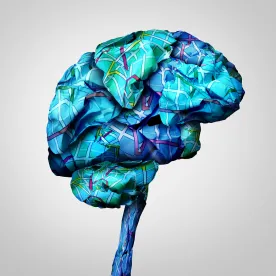A recent Opinion Page article in the New York Times discusses the implications of covert consciousness on patients’ rights. Covert consciousness is a state of consciousness that cannot be detected by bedside examination. The author pointedly asks: “If there is a legal obligation to educate the developing brain, should there not be a correlative responsibility to those whose brains are in a process of redevelopment and recovery?”
The author writes about a patient who was participating in a study of patients with severe brain injury who exhibited the ability to use her left eye to answer simple yes or no questions with an eye tracking device. The young woman had suffered a complex stroke while in college and had been thought to be in a permanently unconscious “vegetative state.” She was subsequently found to be in the “minimally conscious state,” capable of demonstrating intention, attention, and memory.
A paper published in Science Translational Medicine revealed what had happened within the young woman’s brain following her injury. During the recovery of her ability to communicate, her brain basically rewired itself. Using magnetic resonance imaging, researchers demonstrated a strengthening of structural and functional reconnections across the two hemispheres from the region in the frontal lobe responsible for speech. This process appeared to bear a strong resemblance to how the brain develops with its ongoing reorganization of connection among neurons.
Covert Consciousness and Access to Care
Studies show that approximately 10 percent of those patients with severe traumatic brain injuries believed to be in a vegetative state or a minimally conscious state based on a bedside exam can actually follow commands during fMRI or EEG tests. Utilization reviewers and insurance companies deny access to rehabilitation to individuals when they leave the hospital if they are deemed not yet ready for those services. It is vital to accurately identify those patients who may be misdiagnosed and thus not getting the rehabilitation they need.
Also, most rehabilitation stays are six weeks or less. If the brain recovers through a slow process similar to development, six weeks is not enough. The author notes that what is at stake is more than insurance coverage and access to care. It is the basic civil rights of minimally conscious patients. Legal protections may be denied to this population because they have been disenfranchised by their injury.
From pain control to rehabilitation, if minimally conscious patients are misdiagnosed as permanently unconscious, they may be denied services because they are unable to communicate. Worse, they may be segregated in chronic care facilities where no efforts are made in terms of rehabilitation or communication. Correctly diagnosing a patient and taking measures to restore his or her ability to communicate are crucial steps in protecting their legal rights.
Imaging Technology and Patients with Severe Brain Injuries
Massachusetts General Hospital developed functional magnetic resonance imaging (fMRI) which measures brain activity by monitoring changes in blood flow. Electroencephalography, or EEG, detects electrical activity of the brain. In a paper published in the journal Brain, researchers reported a study in which they used fMRI and EEG to detect “covert consciousness” in patients with brain injuries in the intensive care unit.
The Covert Consciousness Study
The study involved 16 patients admitted to the intensive care unit for acute severe traumatic brain injury. The patients lacked behavioural evidence of language expression and comprehension. The researchers’ goal was to determine whether stimulus-based functional MRI and EEG could reveal covert consciousness in patients receiving treatment for acute severe traumatic brain injury. Other goals of the study were to determine whether those tests could uncover higher levels of brain function indicating potential recovery of consciousness, and whether the early brain responses correlate to better long-term outcomes.
Researchers used music as well as language and motor stimuli in assessing brain function. They found evidence of covert consciousness in four patients, including three whose bedside neurological examination suggested a vegetative state. In addition, fMRI and EEG tests identified two other patients whose brains responded to language or music stimuli even though they showed no evidence of language function on bedside examination. A complete absence of responses to language, music and motor imagery was only observed in coma patients.
Why Covert Consciousness is Important
Patients with acute severe traumatic brain injury may recover consciousness before they are able to communicate. Functional MRI and EEG can help patients gain access to rehabilitative care once they are discharged from the intensive care unit.
The observations in the study suggest that fMRI and EEG can detect command-following and higher-order cortical function in patients with acute severe traumatic brain injury. Early detection of covert consciousness and cortical responses in the intensive care unit could alter time-sensitive decisions about the patient’s future.
An inaccurate prognosis, based on a lack of behavioral evidence of consciousness, could lead to a decision to deny rehabilitative services or withhold life-sustaining therapies.



 />i
/>i

